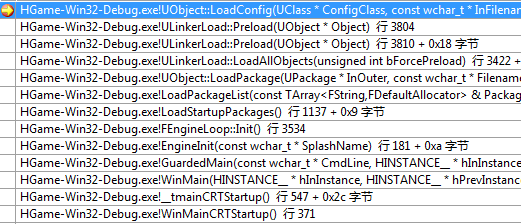unrealscript中有两个与属性自动配置相关的关键字:
config/globalconfig
当把它们应用于属性时,对象在创建后,该属性的初始值会被自动设置为相对应ini文件中的值。
举例来说,如有一个类:
class HNet extends Object
config(game)
native(net);
//var globalconfig string host;
var config string host;
function test() { `Log("HNet test, host is:"@host); }
声明一个带config修饰的属性host,
那么在创建该类实例时,其host会自动设为配置在DefaultGame.ini中的值,其section为【包名.类名】,key就是属性名【host】:
[HGame.HNet]
host=hz.19v5.com
如果ini中没有配置的话,默认值就是空了(或者说该类型自身的默认值)
那么globalconfig区别何在呢?这就与子类的变化有关了
假设有一个子类:
class HHttp extends HNet config(Net) ; function test() { `Log("HHttp test, host is:"@host); }
它有自己的config文件,那么它的host属性,就会去自己的ini中寻找,上例中就是DefaultNet.ini了,
[HGame.HHttp]
host=baidu.com
如果它里面也配置了相应字段,那么在HHttp的实例中,host的值会是baidu.com,而非hz.19v5.com。
而如果作为基类的HNet有这样一种需求:认为其host属性的初始值很重要,不应该被子类乱改,那么就可以改用globalconfig:
用globalconfig修饰的属性,一定会在它的当前类绑定的ini文件中寻找初始值,而无视实际所处子类的ini变更。
在上例中如果host前使用的是globalconfig,那么即使是HHttp类的实例,其host初始值也仍是hz.19v5.com。
功能基本如上所述,下面归纳一下代码中的实现逻辑:
1、首先,UnObjBas.h里定了对应这两个修饰符的标记:
#define CPF_Config DECLARE_UINT64(0x0000000000004000) // Property should be loaded/saved as permanent profile. #define CPF_GlobalConfig DECLARE_UINT64(0x0000000000040000) // Load config from base class, not subclass.
2、在编译脚本时UnSrcCom.cpp,检测到属性声明中有这两修饰符时,会贴上相应标记:
FToken Specifier; GetToken(Specifier); if( Specifier.Matches(NAME_Const) ) { Flags |= CPF_Const; IsVariable = TRUE; } else if( Specifier.Matches(NAME_Config) ) { Flags |= CPF_Config; IsVariable = TRUE; } else if( Specifier.Matches(NAME_GlobalConfig) ) { Flags |= CPF_GlobalConfig | CPF_Config; IsVariable = TRUE; }
3、生成的UClass结构里两个关键属性:字段表和默认对象
UField* Children
UObject* ClassDefaultObject
在脚本里声明的每个属性都是一个UProperty变量,而它正是UField的子类:
// // An UnrealScript variable. // class UProperty : public UField { DECLARE_ABSTRACT_CASTED_CLASS_INTRINSIC(UProperty,UField,0,Core,CASTCLASS_UProperty) DECLARE_WITHIN(UField) // Persistent variables. INT ArrayDim; INT ElementSize; QWORD PropertyFlags; WORD RepOffset; WORD RepIndex;
另外,“默认对象”ClassDefaultObject是unrealscript里的一个特殊概念,每个UClass类都有一个,其作用是:
a、在类加载时,先把ClassDefaultObject创建好,并把各属性初始值(defaultproperties块里的、config文件里的)设置好;
b、以后每次创建实例对象时,都从ClassDefaultObject上拷贝各属性的初始值。
4、创建ClassDefaultObject的地方:
| native类:也就是每个UClass初始化时Register自己的地方 | 纯脚本类:很明显,就是从package里加载数据,刚好加载到一个类时 |
 |
 |
5、ClassDefaultObject读取初始值的地方:

与脚本类的创建不远,同在LoadAllObjects里。
LoadConfig里的逻辑很复杂,但总括起来就两点:去哪里找数据和怎么读,各自都依据情形有大量衍生。但基本的读数据过程都是:
for ( UProperty* Property = ConfigClass->PropertyLink; Property; Property = Property->PropertyLinkNext ) { const UBOOL bGlobalConfig = (Property->PropertyFlags&CPF_GlobalConfig) != 0; UClass* OwnerClass = Property->GetOwnerClass(); UClass* BaseClass = bGlobalConfig ? OwnerClass : ConfigClass; if ( !bPerObject ) { ClassSection = BaseClass->GetPathName(); } // globalconfig properties should always use the owning class's config file // specifying a value for InFilename will override this behavior (as it does with normal properties) const FString& PropFileName = (bGlobalConfig && InFilename == NULL) ? OwnerClass->GetConfigName() : Filename; FString Key = Property->GetName(); debugfSuppressed(NAME_DevSave, TEXT(" Loading value for %s from [%s]"), *Key, *ClassSection); UArrayProperty* Array = Cast<UArrayProperty>( Property ); if( Array == NULL ) { for( INT i=0; i<Property->ArrayDim; i++ ) { if( Property->ArrayDim!=1 ) { Key = FString::Printf(TEXT("%s[%i]"), *Property->GetName(), i); } FString Value; if( GConfig->GetString( *ClassSection, *Key, Value, *PropFileName ) ) { if (Property->ImportText(*Value, (BYTE*)this + Property->Offset + i*Property->ElementSize, PPF_ConfigOnly, this) == NULL) { // this should be an error as the properties from the .ini / .int file are not correctly being read in and probably are affecting things in subtle ways warnf(NAME_Error, TEXT("LoadConfig (%s): import failed for %s in: %s"), *GetPathName(), *Property->GetName(), *Value); }
}
}
}
else
……
……
}
}
也就是遍历每个属性ConfigClass->PropertyLink,逐个解析其配置源、类型(单个还是数组)等问题后,然后一个Property->ImportText,就把数据读进来了。
注意这里对bGlobalConfig的判断:
const FString& PropFileName = (bGlobalConfig && InFilename == NULL) ? OwnerClass->GetConfigName() : Filename;
也就是据此决定了从哪个类的配置文件中去获取数据,实现了上面提到的功能。
6、普通实例创建时从ClassDefaultObject中复制属性数据

也就是在UObject::InitProperties中,完成必要属性(有设定过初值的)的复制:
// Construct anything required. if( DefaultsClass && DefaultData ) { for( UProperty* P=DefaultsClass->ConstructorLink; P; P=P->ConstructorLinkNext ) { if( P->Offset < DefaultsCount ) { // skip if SourceOwnerObject != NULL and this is a transient property - in this // situation, the new value for the property has already been copied from the class defaults // in the block of code above if ( SubobjectRoot == NULL || !P->HasAnyPropertyFlags(CPF_Transient|CPF_DuplicateTransient) ) { // the heap memory allocated at this address is owned the source object, so // zero out the existing data so that the UProperty code doesn't attempt to // de-allocate it before allocating the memory for the new value appMemzero( Data + P->Offset, P->GetSize() );//bad for bools, but not a real problem because they aren't constructed!! P->CopyCompleteValue( Data + P->Offset, DefaultData + P->Offset, SubobjectRoot ? SubobjectRoot : DestObject, DestObject, InstanceGraph ); } } } }
总结:通过以上6步,实现了unrealscript class里带config/globalconfig修饰符属性的自动从配置中加载的功能。